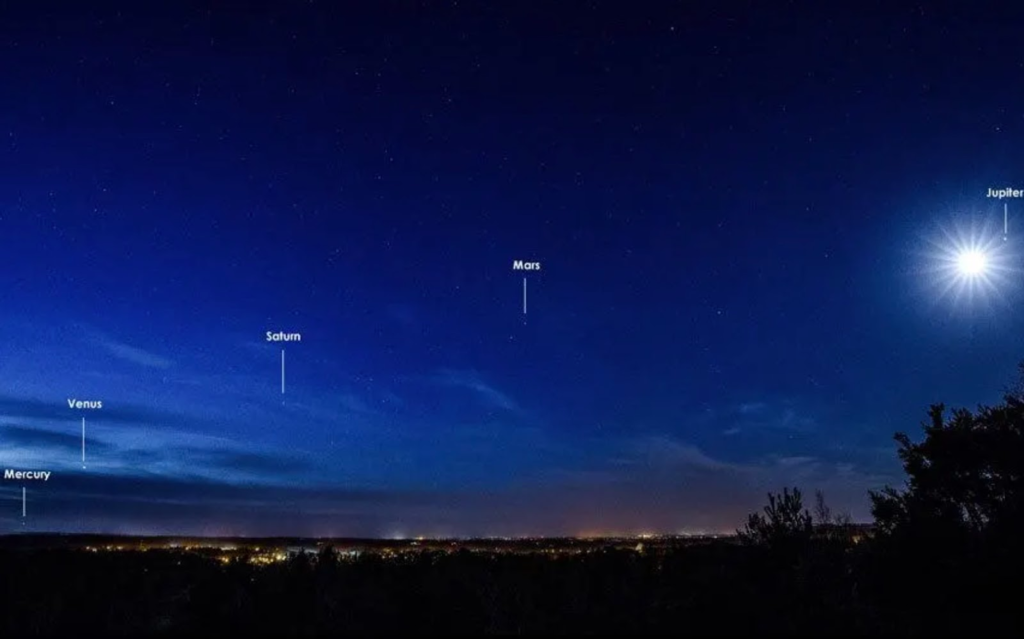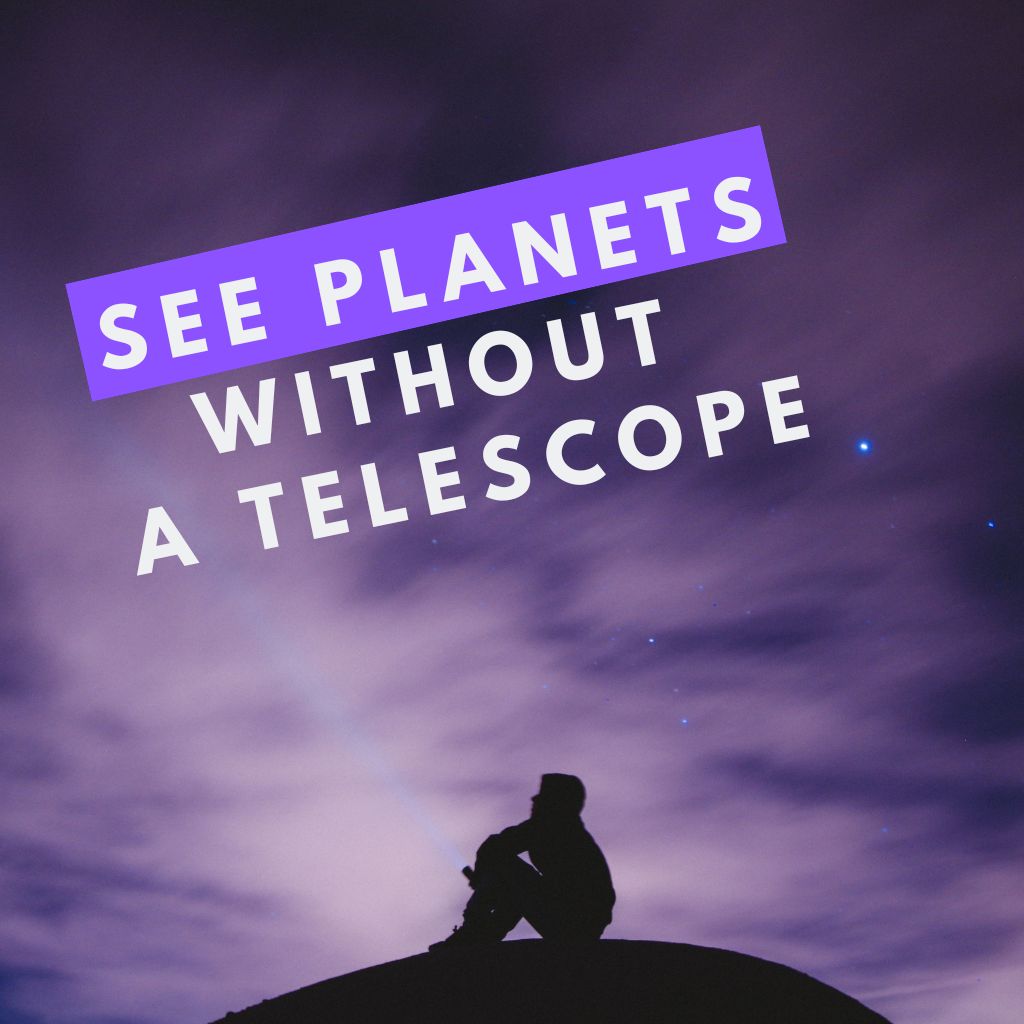This site contains affiliate links to products. I may receive a commission for purchases made through these links.
Astronomy can be a fascinating hobby, but not everyone has access to a telescope. However, that doesn’t mean you can’t enjoy observing the night sky.
Plenty of celestial objects can be seen with the naked eye. In the early evening sky, it is possible to see several planets including Mercury, Venus, Mars, Jupiter, and Saturn without a telescope.
This article will explore which planets can be seen without a telescope and when is the best time to observe them. This article will help you discover if you can identify planets without a telescope.
How many planets can you see without a telescope?
Not all planets are visible without a telescope. Only five planets in our solar system can be seen without using a telescope. In fact, only a handful of planets can be seen without magnification.

Can the planet Mercury be seen without a telescope?
Mercury can be seen without a telescope, but it can be challenging to spot due to its proximity to the Sun and its short time visible in the sky before sunrise or after sunset.
It is challenging to spot Mercury with the naked eye as it never strays far from the Sun. However, it is possible to see Mercury just after sunset or just before sunrise when the planet is at its greatest elongation, which is the furthest distance it can get from the Sun as seen from Earth.
This typically happens two or three times a day. Because Mercury is so close to the Sun, it is only visible for a short period each day. This is when the Sun is below the horizon, but the sky is still bright enough to see the planet and can last for several days.
Mercury is brighter when it is at its greatest elongation, as it is closer to Earth and reflects more sunlight. However, it still appears much dimmer than the brightest stars and planets, so you need a clear view of the horizon and a bit of patience to find it.
Mercury’s position in the sky changes rapidly from night to night, so it is important to check a sky chart or astronomy app to find out where it will be on a particular day.
It is also a good idea to find a location with a clear view of the horizon and minimal light pollution to improve your chances of spotting it.
How to spot Mercury in the sky without a telescope
- Find a clear and unobstructed view of the horizon.
- Look towards the western horizon during dusk or the eastern horizon before dawn.
- Mercury is the closest planet to the sun, so it will appear relatively close to the sun in the sky.
- Look for a bright star-like object that appears just above or just below the horizon.
- Use a star chart or a planetarium app to help you identify the location of Mercury in the sky.
- If you are having trouble spotting Mercury, try using binoculars to get a closer look.
Can you see planet Venus without a telescope?
Venus is the second planet from the Sun and is often referred to as the “morning star” or “evening star” due to its brightness. Venus is the brightest object in the night sky after the Moon and is visible to the naked eye.
It is most easily seen just after sunset or just before sunrise and can appear as a bright, white, star-like object in the sky.
Venus is the closest planet to Earth, and its orbit is inside the Earth’s orbit around the Sun. This means that Venus can appear at different points in the sky depending on the time of year and is visible for different lengths of time throughout the year.
Venus is so bright that it can often be seen during the day, especially if you know where to look. However, it is essential never to look directly at the Sun when trying to spot Venus during the day, as this can cause permanent eye damage.
Because Venus is so bright, it is sometimes mistaken for a UFO or other mysterious object in the sky. However, once you know what to look for, it is easy to identify Venus by its steady, unblinking light and its position in the sky relative to the Sun.
Venus has a thick atmosphere that reflects a lot of sunlight, making it appear even brighter in the sky. However, this also means that Venus has a runaway greenhouse effect, and its surface temperature is hot enough to melt lead.
How to see Venus without a telescope
- Look for Venus in the western sky after sunset or in the eastern sky before sunrise.
- Look for a bright, white, star-like object that doesn’t twinkle like a star. This is because Venus is actually a planet and not a star.
- You can also use a star chart or a mobile app to help you locate Venus in the sky.
- Look for Venus during its phases, which can range from a thin crescent to a nearly full disk. These phases are caused by the planet’s orbit around the sun and its position relative to Earth.
- If you have binoculars, you may be able to see Venus’s phases more clearly. However, it’s not necessary to use binoculars or a telescope to see Venus in the sky.
Can planet Mars be seen without a telescope?
Mars is the fourth planet from the Sun and is often called the “Red Planet” due to its reddish appearance. Mars is visible to the naked eye and can be seen as a bright, reddish-orange object in the sky.
The best time to see Mars is during its opposition, which occurs when Earth passes between Mars and the Sun. During opposition, Mars is at its closest distance to Earth, and it appears larger and brighter than at any other time.
The apparent brightness and visibility of Mars also depend on its position in the sky and the observer’s location on Earth. Mars’s orbit is more elliptical than Earth’s, so its distance from our planet varies over time.
When Mars is at its closest point to Earth, it is around 34 million miles away, which makes it one of the most visible and brightest objects in the night sky.
However, when it is at its farthest point from Earth, it can be over 250 million miles away, making it much harder to see.
The visibility of Mars also depends on the weather conditions and atmospheric disturbances in the observer’s location. For example, viewing Mars from a location with a lot of light pollution or cloudy skies may not be possible, even during its opposition.
Furthermore, the visibility of Mars to the naked eye is not as clear as what a telescope can offer.
With a telescope, you can see more details of the planet, such as its polar ice caps, dust storms, and even some of its geological features, like the Valles Marineris, which is a vast canyon system on Mars.
How to spot Mars without a telescope
- Check the date. Mars is visible to the naked eye during its opposition, which happens once every 26 months when Earth and Mars are closest together.
- Go to a location away from city lights and light pollution.
- Look for a red star-like object: Mars has a distinct reddish hue that sets it apart from the other stars.
- Use a star chart to help you locate Mars in the night sky.
- Look to the east. Mars rises in the east just after sunset and moves across the sky until it sets in the west just before sunrise.
- Check the weather and make sure the sky is clear and free of clouds to increase your chances of spotting Mars.
Can you see Jupiter without a telescope?
Jupiter is the largest planet in our solar system and is known for its bright, white appearance. Jupiter is visible to the naked eye and is often one of the brightest objects in the night sky, aside from the Moon and Venus.
It can be seen as a bright, star-like object in the sky, and its four largest moons, known as the Galilean moons, can also be seen with binoculars or a small telescope.
Jupiter can be seen without a telescope from almost anywhere on Earth, as long as the sky is clear and there is no light pollution. It is most visible during the opposition, which is when Jupiter and Earth are on the same side of the Sun and, therefore, closest to each other.
During opposition, Jupiter will appear brighter and larger in the sky, making it even easier to spot.
In addition to the Galilean moons, Jupiter has a faint ring system that can be seen with a larger telescope. The rings are made up of small particles of rock and ice and are not as prominent as those of Saturn, but they can still be a fascinating sight for amateur astronomers.
How to spot Jupiter without a telescope
- Check the time: Jupiter is best viewed in the late evening or early morning hours.
- Find a clear sky: Jupiter is visible to the naked eye, but you will need a clear sky without any clouds or light pollution to see it clearly.
- Look for a bright star-like object: Jupiter will appear as a bright, star-like object in the sky.
- Use binoculars: If you have binoculars, you can use them to get a better view of Jupiter and its four largest moons, known as the Galilean moons.
You may also like: 11 Best Telescopes to See Jupiter (Planet, Red Spot, and Moons)
Can you see Saturn without a telescope?
Saturn is the sixth planet from the Sun and is known for its spectacular rings. Saturn is visible to the naked eye and can be seen as a bright, yellowish-white object in the sky. Its rings can be seen with a small telescope or binoculars.
Saturn is one of the most beautiful objects to observe in the night sky and can be seen without a telescope from a dark location with no light pollution.
It is usually visible to the naked eye during the opposition when the planet is closest to Earth and fully illuminated by the Sun.
The ringed planet has a unique appearance that makes it easy to identify. Its yellowish-white color and distinct shape, combined with its rings, make it stand out from other celestial objects.
However, it is important to note that the naked-eye view of Saturn is less impressive than the view through a telescope, as you can’t see its rings in so much detail.
Saturn’s rings are made up of countless icy particles ranging in size from tiny dust grains to large boulders. They are not solid, and there are gaps and divisions within them that can be seen with a telescope.
While Saturn can be seen without a telescope, using a small telescope or binoculars can enhance the viewing experience and allow for a more detailed observation of its magnificent rings.
How to spot Saturn without a telescope
- Find a clear and dark sky away from city lights, as light pollution can make it difficult to see the planet.
- Look towards the southeastern part of the sky after sunset. Saturn will be visible in this direction.
- Look for a bright, yellowish-white object in the sky. Saturn will appear as a bright object in the sky, similar to a star but with a steady glow.
- Observe the object closely. If you’re able to spot Saturn, you may be able to see its rings with the naked eye. The rings will appear as two faint lines on either side of the planet.
Read also: How Big of a Telescope Do You Need to See Saturn’s Rings?
Can you see Pluto without a telescope?
Pluto is no longer classified as a planet but is now considered a dwarf planet. Pluto is too small and too far away to be seen with the naked eye, so a telescope is required to observe it.
However, it is challenging to observe due to its dimness and distance from Earth.
Pluto is located in the outer reaches of our solar system, and its distance from Earth can vary widely depending on its position in orbit.
Pluto is still about 2.66 billion miles (4.28 billion kilometers) away at its closest approach, making it the farthest planet-like object in our solar system. Its distance from Earth and its small size make it very difficult to observe without a telescope.
Astronomers must use special techniques and equipment to observe Pluto with a telescope, such as long exposure photography and advanced image processing software.
Even with these tools, Pluto will appear as a small dot of light and will not show any detail on its surface.
Can you see Neptune without a telescope?
Neptune is the eighth and farthest planet from the Sun in our solar system. It is much further away from Earth than Uranus, making it much more challenging to see without a telescope.
However, it is possible to see Neptune with binoculars or a small telescope, provided you have excellent viewing conditions and a dark sky. It appears as a small, bluish-green disc, but it is not as visible as other planets in our solar system.
Neptune is much fainter than the other planets due to its distance from the Sun and Earth.
Neptune’s atmosphere is primarily composed of hydrogen, helium, and methane gas, which gives it its distinctive blue-green color. The gas giant also has a series of dark spots and bright clouds that can be seen with a telescope.
To observe Neptune, you will need a telescope with a large aperture, preferably 8 inches or larger, and a high magnification eyepiece.
A recommended telescope for viewing Neptune is the Celestron NexStar 8SE.
And if you are looking for a more affordable option, Orion SkyQuest XT8i Dobsonian Telescope is a great option.
Read more: What Size Telescope Do I Need to See Neptune?
Can you see Uranus without a telescope?
Uranus cannot be seen without a telescope. It is the seventh planet from the Sun and is located over 1.8 billion miles (2.9 billion kilometers) from Earth, making it too distant and dim to be visible to the naked eye.
However, Uranus is visible with a telescope as a small, pale blue-green disc. The planet’s atmosphere is primarily composed of hydrogen, helium, and methane gas, which gives it its distinctive color.
There are two telescopes that are recommended for observing Uranus. One of them is the Celestron NexStar 6SE Telescope. This high-quality telescope features a six-inch aperture and a computerized mount that can locate Uranus for you automatically.
Sky-Watcher Collapsible Dobsonian 10-inch Telescope is another great option. The large aperture allows for detailed views of Uranus and other celestial objects.
What planets can be seen at night without a telescope?
Venus, Jupiter, and Saturn are the planets that can be seen at night without a telescope. They are often visible as bright, star-like objects in the night sky, and their brightness can even rival some of the brightest stars in the sky.
What is the farthest planet that can be seen without a telescope?
The farthest planet that can be seen without a telescope is Saturn. Saturn is the sixth planet from the Sun and appears as a bright, yellowish-white object in the night sky.
It is one of the five planets that have been visible to the naked eye since ancient times and can be easily spotted in the sky without the aid of a telescope.
FAQs about which planets can be seen without a telescope
Let’s answer some frequently asked questions about which planets are visible to the naked eye and which ones require the use of a telescope.
Can you observe the alignment of five planets without a telescope?
You can observe the alignment of five planets without a telescope- Venus, Mars, Jupiter, Mercury, and Uranus. However, this event is quite rare and requires specific alignment of the planets in our solar system.
Which planets cannot be seen without a telescope?
Most of the planets in our solar system can be seen without a telescope, but Uranus and Neptune are typically not visible to the naked eye.
Uranus is located over 1.8 billion miles (2.9 billion kilometers) away from Earth, making it too dim to be seen without a telescope.
Neptune is even further away, located over 2.7 billion miles (4.3 billion kilometers) from Earth, and is also too dim to be seen without a telescope.
Takeaway: Discover the brilliance of the brightest planets with the naked eye
There are several planets in our solar system that you can see without a telescope. They are Mercury, Venus, Mars, Jupiter, and Saturn.
These planets are often visible as bright, star-like objects in the night sky, and their brightness can even rival that of some of the brightest stars in the sky.
Other planets, such as Uranus and Neptune, are technically visible to the naked eye, but they are much dimmer and more challenging to spot without a telescope.
While observing the planets without a telescope can be a fun and exciting experience, it’s important to remember that the use of binoculars or a small telescope can enhance the viewing experience and allow for a better view of these celestial objects.
You may also like:





